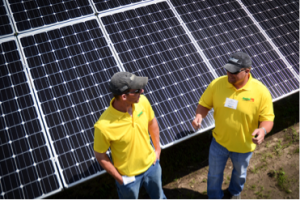By Erin Campbell, CCC, Iowa Association of Electric Cooperatives

I’d bet money that solar generation is a hot topic at your cooperative in one way or another. For some co-ops, their boards are actively exploring how to add community solar options for their members. For other co-ops, your member services department is fielding calls from members who want to know their options regarding rooftop solar. And if your co-op isn’t involved with solar yet, it’s only a matter of time. While states like California and Arizona have been handling consumer rooftop solar for several years, many other states are just dipping their toes in the water. Utility boards and regulatory commissions in several states are working through complicated issues involving net metering, solar interconnections, rate design, and third-party ownership of solar which will directly impact our co-ops and our members.
Back in 2013, electric cooperatives in Iowa asked the Iowa Association of Electric Cooperatives to form a special Distributed Generation Task Force to stay on top of industry trends, policies, and regulations regarding solar generation. While reviewing regulations and scouring headlines on behalf of our member cooperatives, we discovered that there are very few neutral, unbiased resources for homeowners who are considering rooftop or ground mount solar DG. Often times, our members rely completely on a solar vendor for information and the cooperative isn’t contacted until late in the installation process.
Earlier this year, our DG Task Force set out to develop a series of informative documents intended to help co-op members who were considering installing their own solar generation. After a thorough technical and legal review for our state’s policies, we provided Iowa co-ops with four key documents:
- Solar Generation: Myths vs. Facts
- Solar Generation: Frequently Asked Questions
- Solar Generation: Top 10 Considerations
- Solar Generation: Questions to Ask Your Solar Vendor
You can find these documents at www.iowarec.org/energy. By providing these resources, our goal is to establish Iowa’s cooperatives as a trusted source of solar information and that as a result; member-owners will involve the co-op early in the decision-making process and make smart choices. As you look through the documents, you’ll notice that we placed great emphasis on the importance of energy efficiency, which is rarely addressed by solar vendors. We also want members to thoroughly investigate this major investment, just as they would take time to research options when purchasing a new vehicle or finishing a basement.
Right now in Iowa, cooperatives are incorporating solar generation in a variety of ways. Some co-ops are offering long-term community solar subscriptions to their members. One Iowa co-op installs rooftop and ground mount solar systems for members in addition to offering community solar. And probably like many other states, a majority of Iowa’s co-ops continue to explore rate and solar options as their boards work make long-term decisions in the best interests of members.
While it can be tempting to vilify our solar DG members, it’s important to remember that solar DG is not the issue; rate design is the issue. For over 100 years, utilities effectively powered people’s lives through central station generation and an all-inclusive kilowatt-hour rate. With the advent of wind and solar distributed generation and the reduction in DG installation costs, consumers now have the ability to generate electricity to meet some or all of their needs with the possibility of selling excess on the grid. The central station rate model wasn’t designed to handle these variables and utilities are actively looking for a better model that will recover the costs of maintaining the electric grid for those who use it to consume and/or distribute electricity. Recent advances in electric storage will add another layer of complexity to this issue.
So what does this all mean for communicators? As we work in the midst of this major shift in rate structure and how electricity is generated and stored, co-op communicators must clearly explain these concepts to the membership while also conveying the relevance of the cooperative advantage. It’s important to reiterate that the co-op exists to serve the long-term energy needs of our members; for those who own DG and those who don’t. Our members are looking for information they can trust in regard to solar generation and storage and cooperatives are perfectly poised to fill that void. We can engage our members in a dialogue about their energy goals and help them make smart choices based on realistic expectations. Co-op communicators are crucial to the success of this endeavor.
I would also encourage you to talk to your local media contacts about how your co-op and board is working to balance renewable generation with affordability for your members. In most cases, reporters and editors are not aware of utility concepts like baseload generation, rate structure or cost recovery and you can help educate them on the complexities of DG.
Finally, I advise distribution cooperative communicators to reach out to NRECA, your statewide association and your G&T as you craft your messaging related to distributed generation. We can help you frame the conversation and position your co-op as a trusted resource. This is an exciting and, at times, daunting era for the utility industry, but we can communicate the most effectively to our stakeholders when we collaborate.
